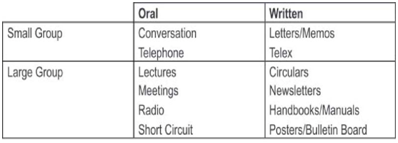Written Communication:
Written communications involved personal letters, memoranda, policy and procedure manuals, and remembered placed on the notice boards. Examples of oral communications are conferences, telephone conversation, committee meetings, loudspeaker announcements, etc. Both written and oral communications have their merits and demerits.

Figure: Different Verbal Media in Organisational Communication
A written communication has the advantages of being simply verifiable, more precise and accurate. For clarity, we must use easy and familiar words or phrases and short sentences. Spoken messages cannot always be verified so simply. However, written communication becomes absolutely essential while dealing with lengthy and complicated messages. It would be difficult to understand and retain a lengthy message if it were only in oral form. In spite of such advantages, written communication has drawbacks such as the following:
- Being slow, if we consider the total amount of time involved from the formulation of idea by the sender to the understanding of the idea by the receiver.
- Ambiguity or lack of clarity despite the fact that a greater degree of preciseness is aimed at while preparing a written communication.
- Too much paper-work due to over-reliance on written communication. This not only consumes time, money and energy, but also infuses a lack of trust among the employees of the organisation.